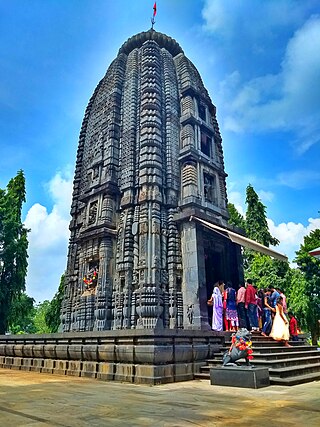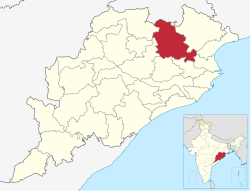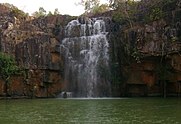
Mayurbhanj district is one of the 30 districts in the Odisha state of eastern India. It holds the distinction of being the largest district in Odisha by area. The district's headquarters is located in Baripada, with other major towns including Rairangpur, Karanjia, and Bahalda. As of 2011, Mayurbhanj ranks as the third-most populous district in Odisha, following Ganjam and Cuttack.
Anandapur (ଆନନ୍ଦପୁର) is a town and a municipality of Kendujhar district in the state of Odisha, India.
Barbil is a city and a Municipal Council in the Kendujhar district of the state of Odisha, India. The region around Barbil has one of the largest deposits of iron ore and manganese ore in the world. It is a major source of revenue generation for both the central and the state governments.
Champua is a notified area council in Kendujhar district in the state of Odisha, India.As per SC & ST department of Odisha, the Champua sub-division is under scheduled areas of Odisha. Nicholson Forest training institute is present here. The suburb has its importance as it provides a major trade route for transport of iron ore and manganese from some of the major mines of the state to the nearest port & out-state depots. It is also known for its pre-independence truss bridge built by British rulers, the judicial buildings of the same period as well as a few educational institutes who have a good reputation in the state. The river Baitarani flows by Champua, which is one of the largest rivers of the state second only to Mahanadi.
Joda Town is a town and municipality in Keonjhar district, popularly known as Joda Municipality Town in Joda Block, located near Barbil City or Barbil Tahsil which is only 14 km away from. Joda Town is surrounded by the well-known Mahendragiri Parvat Shrunkhala- an ancient series of hills described in history of Bharata Varsha and in the epic Ramayana and Mahabharata, which are spread in from Keonjhar to Sundargarh, Koraput, Kandhamal, Rayagada and Visakhapatnam.

The Juang are an Austroasiatic ethnic group found only in the Gonsaika hills of Keonjhar district of Odisha. Some Juangs, however migrated to neighbouring plains of Dhenkanal district of Odisha during the Bhuiyan revolt in the late 19th century. The Juang language belongs to the Munda family of the Austroasiatic languages. They are classified as a Scheduled Tribe by the Indian government. The 2011 census showed their population to be around 50,000.

Maharaja Sriram Chandra Bhanja Deo University, formerly North Orissa University (NOU), is a public university in the regional city of Baripada in the state of Odisha, India.

The Bhuiyan or Bhuiya are an indigenous community found in the Indian states of Bihar, Jharkhand, Madhya Pradesh, Odisha, Uttar Pradesh and West Bengal. They are not only geographically disparate but also have many cultural variations and subgroups.
Kendujhargarh railway station, located in the Indian state of Odisha, serves Kendujhar in Kendujhar district. It is on the Padapahar–Jakhapura branch line.
Champua is a Vidhan Sabha constituency of Kendujhar district. Area of this constituency includes Joda, Barbil, Joda block and 17 GPs of Champua block.
Keonjhar is a Vidhan Sabha constituency of Kendujhar district. Area of this constituency includes Keonjhar, 12 GPs of Jhumpura block and 5 GPs of Banspal block.
Patna is one of the 147 Legislative Assembly constituencies of Odisha state in India. It is in Kendujhar district" and is reserved for candidates belonging to the Scheduled Tribes. It is a segment of the Kendujhar parliamentary constituency.

The Bhanja dynasty is a dynasty that originated in the northern and central regions of modern Odisha before the Gupta Empire became an imperial power. The dynasty, of ancient local Kshatriya lineage as documented by Hermann Kulke, succeeded the Vindhyatabi branch of the Nagas of Padmavati, who ruled from the Keonjhar district of Odisha and included Satrubhanja of the Asanpat inscription. The Bhanj later became feudatories of the Bhauma-Kara dynasty.

Keonjhar State, also known as Keunjhar, was one of the princely states of India during the period of the British Raj. The second largest of the states of the Orissa States Agency, it was located in present-day Kendujhar district, Odisha.
Banspani railway station (BSPX) serves Joda Municipality Town, Odisha and it is the smallest railway station of India with only 1 number of platform of 200meter length. Also its a second major iron ore loading station, following Jaroli railway station-the highest iron ore loading station of the Indian Railways. Only two passenger trains Barbil-Puri-Barbil Indian class Intercity Express and Visakhapattnam-Tatanagar-Visakhapattnam Weekly Late Express runs through this station.
Purusottampur, is a village in the taluk of Champua, district of Kendujhar, in the Indian state of Odisha. The total geographical area of village is 160 hectares.
Khireitangiri is a village located in Patna Tehsil in the Kendujhar District in the Indian state of Odisha.
Dharanidhar Naik was a tribal leader of Keonjhar who fought battle against Dhanurjay Bhanja during British rule in Odisha.
Kendujhar Sadar is an administrative unit in the Kendujhar district in the state of Odisha, India. This subdivision consists of the town Keundujhar, the administrative headquarters of the eponymous district.















